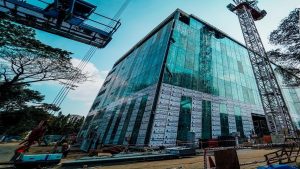NEW DELHI: Defence Minister Rajnath Singh has inaugurated a multi-storey facility for flight control system at Aeronautical Development Establishment here built by India’s premier defence research institute DRDO in a record 45 days using in-house technology.
Karnataka Chief Minister Basavaraj Bommai was among those present on the occasion.
 The seven-storey building, with a plinth area of 1.3 lakh square feet, will house research and development facilities for the development of a fifth-generation medium weight deep penetration fighter jet for the Indian Air Force.
The seven-storey building, with a plinth area of 1.3 lakh square feet, will house research and development facilities for the development of a fifth-generation medium weight deep penetration fighter jet for the Indian Air Force.
“The DRDO has completed the construction of a multi-storey infrastructure for flight control system at ADE Bengaluru with hybrid technology consisting of conventional, pre-engineered and precast methodology in record 45 days,” said one of the DRDO officials.
He said the complex will have facilities for developing avionics for fighter aircraft and flight control system (FCS) for the Advanced Medium Combat Aircraft (AMCA) project.
India has been working on the ambitious AMCA project to develop a fifth-generation medium fighter jet with advanced stealth features to significantly bolster its air power capability.
The initial development cost of the project, being undertaken by the ADE, has been estimated at around Rs 15,000 crore.
The Defence ministry on Monday said it has initiated the process of obtaining the approval for the design and prototype development of the AMCA from the prime minister-led Cabinet Committee on Security.
Officials said the building has been constructed using composite construction technology in the “shortest time frame” of just 45 days to provide the necessary infrastructure for the AMCA project and related activities.
The foundation stone for the project was laid on Nov 22, 2021, and actual construction began on February 1.
“It is a unique record of completing a permanent seven-storey building with hybrid construction technology, that too in ready-to-move condition for the first time in the country, the official involved in the project claimed.
In hybrid construction technology, the column and beam elements of the structural frame are built with steel plates, the columns are of hollow steel tubular section.
The building features air-conditioning, electrical and fire protection systems as per the standard national building code and the design check and technical support was provided by teams from IIT Madras and IIT Roorkee, the officials said.
Source: Press Trust of India
